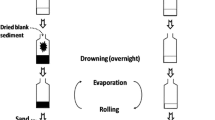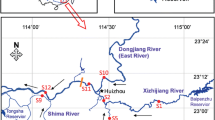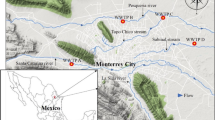Abstract
Introduction
Endocrine disrupting chemicals (EDCs) are present in the environment and can have serious effects on humans and wildlife. For the establishment of environmental quality guidelines and regulation of EDCs, a better understanding and knowledge of the occurrence and the behavior of environmental EDCs is necessary. The aim of the present study was to comprehensively identify substances that are responsible for the estrogenic effect of an environmental sediment sample taken from the river Elbe/Germany.
Discussion
The estrogenic effect of the organic sediment extract was determined using the yeast–estrogen–screen (YES). The sample was fractionated by liquid chromatography (LC) for effect directed analysis. The composition of estrogen-active fractions was further investigated by gas chromatography–mass spectrometry and high-resolution LC–MS analysis. The composition of the environmental sample was rebuilt with pure compounds in order to assess the partition of estrogenic activity caused by the identified compounds. The organic sediment extract showed an estrogenic potential of 1.9 ± 0.4 ng/g ethinylestradiol equivalents in the sediment. The most prominent contaminants with an estrogenic potential were 17β-estradiol, estrone, and 4-iso-nonylphenols, but other xenoestrogens like bisphenol A and stigmasterol could be found as well. A rebuild of the sample was measured in the YES in order to investigate mixture effects. About 67 % of the observed estrogenic effect in the sediment extract could be explained by a mixture which contained all identified compounds. Chlorophene (o-benzyl-p-chlorophenol)—a widely used antiseptic that was also identified in the sediment extract—has xenoestrogenic properties in the YES that are in the range of other xenoestrogens like 4-n-nonylphenol. This is the first report on chlorophene acting as a xenoestrogen.






Similar content being viewed by others
References
Aerni HR, Kobler B, Rutishauser BV, Wettstein FE, Fischer R, Giger W, Hungerbuhler A, Marazuela MD, Peter A, Schonenberger R, Vogeli AC, Suter MJ, Eggen RI (2004) Combined biological and chemical assessment of estrogenic activities in wastewater treatment plant effluents. Anal Bioanal Chem 378:688–696
Andersen H, Siegrist H, Halling-Sorensen B, Ternes TA (2003) Fate of estrogens in a municipal sewage treatment plant. Environ Sci Technol 37:4021–4026
Brack W, Klamer HJ, Lopez de Alda M, Barcelo D (2007) Effect-directed analysis of key toxicants in European river basins a review. Environ Sci Pollut Res Int 14:30–38
Brack W, Schmitt-Jansen M, Machala M, Brix R, Barcelo D, Schymanski E, Streck G, Schulze T (2008) How to confirm identified toxicants in effect-directed analysis. Anal Bioanal Chem 390:1959–1973
Burnison BK, Hartmann A, Lister A, Servos MR, Ternes T, Van Der Kraak G (2003) A toxicity identification evaluation approach to studying estrogenic substances in hog manure and agricultural runoff. Environ Toxicol Chem 22:2243–2250
Carballa M, Omil F, Lema JM, Llompart M, García-Jares C, Rodríguez I, Gómez M, Ternes T (2004) Behavior of pharmaceuticals, cosmetics and hormones in a sewage treatment plant. Water Res 38:2918–2926
Colborn T, vom Saal FS, Soto AM (1993) Developmental effects of endocrine-disrupting chemicals in wildlife and humans. Environ Health Perspect 101:378–384
Combalbert S, Hernandez-Raquet G (2010) Occurrence, fate, and biodegradation of estrogens in sewage and manure. Appl Microbiol Biotechnol 86:1671–1692
Danish-QSAR (2011) http://130.226.165.14/index.html. Accessed 28 Oct 2011
Daughton CG, Ternes TA (1999) Pharmaceuticals and personal care products in the environment: agents of subtle change? Environ Health Perspect 107(Suppl 6):907–938
Davoren M, Fogarty AM (2005) Ecotoxicological evaluation of the biocidal agents sodium o-phenylphenol, sodium o-benzyl-p-chlorophenol, and sodium p-tertiary amylphenol. Ecotoxicol Environ Saf 60:203–212
Grund S, Keiter S, Bottcher M, Seitz N, Wurm K, Manz W, Hollert H, Braunbeck T (2010) Assessment of fish health status in the Upper Danube River by investigation of ultrastructural alterations in the liver of barbel Barbus barbus. Dis Aquat Organ 88(3):235–248
Grund S, Higley E, Schonenberger R, Suter MJ, Giesy JP, Braunbeck T, Hecker M, Hollert H (2011) The endocrine disrupting potential of sediments from the Upper Danube River (Germany) as revealed by in vitro bioassays and chemical analysis. Environ Sci Pollut Res Int 18:446–460
Hashimoto S, Ueda Y, Kurihara R, Shiraishi F (2007) Comparison of the estrogenic activities of seawater extracts from Suruga Bay, Japan, based on chemical analysis or bioassay. Environ Toxicol Chem 26:279–286
Hecker M, Karbe L (2005) Parasitism in fish - an endocrine modulator of ecological relevance? Aquatic toxicology (Amsterdam, Netherlands) 72(3):195–207
Hecker M, Hollert H (2009) Effect-directed analysis (EDA) in aquatic ecotoxicology: state of the art and future challenges. Environ Sci Pollut Res Int 16:607–613
Hecker M, Tyler CR, Hoffmann M, Maddix S, Karbe L (2002) Plasma biomarkers in fish provide evidence for endocrine modulation in the Elbe River, Germany. Environ Sci Technol 36(11):2311–2321
Heemken OP, Reincke H, Stachel B, Theobald N (2001) The occurrence of xenoestrogens in the Elbe river and the North Sea. Chemosphere 45(3):245–259
Hollert H, Durr M, Holtey-Weber R, Islinger M, Brack W, Farber H, Erdinger L, Braunbeck T (2005) Endocrine disruption of water and sediment extracts in a non-radioactive dot blot/RNAse protection-assay using isolated hepatocytes of rainbow trout. Environ Sci Pollut Res Int 12:347–360
Holthaus K, Johnson A, Jurgens M, Williams R, Smith J, Carter J (2002) The potential for estradiol and ethinylestradiol to sorb to suspended and bed sediments in some English rivers. Environ Toxicol Chem 21:2526–2535
Houtman CJ, Van Oostveen AM, Brouwer A, Lamoree MH, Legler J (2004) Identification of estrogenic compounds in fish bile using bioassay-directed fractionation. Environ Sci Technol 38:6415–6423
Houtman CJ, Booij P, Jover E, Pascual del Rio D, Swart K, van Velzen M, Vreuls R, Legler J, Brouwer A, Lamoree MH (2006) Estrogenic and dioxin-like compounds in sediment from Zierikzee harbour identified with CALUX assay-directed fractionation combined with one and two dimensional gas chromatography analyses. Chemosphere 65:2244–2252
Hutchins SR, White MV, Hudson FM, Fine DD (2007) Analysis of lagoon samples from different concentrated animal feeding operations for estrogens and estrogen conjugates. Environ Sci Technol 41:738–744
Johnson AC, Sumpter JP (2001) Removal of endocrine-disrupting chemicals in activated sludge treatment works. Environ Sci Technol 35:4697–4703
Kase R, Hansen PD, Fischer B, Manz W, Heininger P, Reifferscheid G (2008) Integral assessment of estrogenic potentials of sediment-associated samples. Part 1: the influence of salinity on the in vitro tests ELRA, E-Screen and YES. Environ Sci Pollut Res Int 15:75–83
Kidd KA, Blanchfield PJ, Mills KH, Palace VP, Evans RE, Lazorchak JM, Flick RW (2007) Collapse of a fish population after exposure to a synthetic estrogen. Proc Natl Acad Sci USA 104:8897–8901
Kinani S, Bouchonnet S, Bourcier S, Creusot N, Porcher JM, Ait-Aissa S (2008) Extraction and purification procedures for simultaneous quantification of phenolic xenoestrogens and steroid estrogens in river sediment by gas chromatography/ion trap mass spectrometry. Rapid Commun Mass Spectrom 22:3651–3661
Kinani S, Bouchonnet S, Creusot N, Bourcier S, Balaguer P, Porcher JM, Ait-Aissa S (2010) Bioanalytical characterisation of multiple endocrine- and dioxin-like activities in sediments from reference and impacted small rivers. Environ Pollut 158:74–83
Korner W, Hanf V, Schuller W, Kempter C, Metzger J, Hagenmaier H (1999) Development of a sensitive E-screen assay for quantitative analysis of estrogenic activity in municipal sewage plant effluents. Sci Total Environ 225:33–48
Kuch B, Kern F, Metzger JW, von der Trenck KT (2010) Effect-related monitoring: estrogen-like substances in groundwater. Environ Sci Pollut Res Int 17:250–260
Lamoureux EM, Brownawell BJ (1999) Chemical and biological availability of sediment-sorbed hydrophobic organic contaminants. Environ Toxicol Chem 18:1733–1741
Legler J, Dennekamp M, Vethaak AD, Brouwer A, Koeman JH, van der Burg B, Murk AJ (2002) Detection of estrogenic activity in sediment-associated compounds using in vitro reporter gene assays. Sci Total Environ 293:69–83
McDonnell DP, Nawaz Z, Densmore C, Weigel NL, Pham TA, Clark JH, O’Malley BW (1991a) High level expression of biologically active estrogen receptor in Saccharomyces cerevisiae. J Steroid Biochem Mol Biol 39:291–297
McDonnell DP, Nawaz Z, O’Malley BW (1991b) In situ distinction between steroid receptor binding and transactivation at a target gene. Mol Cell Biol 11:4350–4355
Nakada N, Tanishima T, Shinohara H, Kiri K, Takada H (2006) Pharmaceutical chemicals and endocrine disrupters in municipal wastewater in Tokyo and their removal during activated sludge treatment. Water Res 40:3297–3303
Noppe H, Verslycke T, De Wulf E, Verheyden K, Monteyne E, Van Caeter P, Janssen CR, De brabander HF (2007) Occurrence of estrogens in the Scheldt estuary: a 2-year survey. Ecotoxicol Environ Saf 66:1–8
Peck M, Gibson RW, Kortenkamp A, Hill EM (2004) Sediments are major sinks of steroidal estrogens in two United Kingdom rivers. Environ Toxicol Chem 23:945–952
Raman DR, Williams EL, Layton AC, Burns RT, Easter JP, Daugherty AS, Mullen MD, Sayler GS (2004) Estrogen content of dairy and swine wastes. Environ Sci Technol 38:3567–3573
Reifferscheid G, Heil J, Oda Y, Zahn RK (1991) A microplate version of the SOS/umu-test for rapid detection of genotoxins and genotoxic potentials of environmental samples. Mutat Res 253:215–222
Reifferscheid G, Buchinger S, Cao Z, Claus E (2011) Identification of mutagens in freshwater sediments by the Ames-fluctuation assay using nitroreductase and acetyltransferase overproducing test strains. Environ Mol Mutagen 52:397–408
Servos MR, Bennie DT, Burnison BK, Jurkovic A, McInnis R, Neheli T, Schnell A, Seto P, Smyth SA, Ternes TA (2005) Distribution of estrogens, 17beta-estradiol and estrone, in Canadian municipal wastewater treatment plants. Sci Total Environ 336:155–170
Shappell NW, Billey LO, Forbes D, Matheny TA, Poach ME, Reddy GB, Hunt PG (2007) Estrogenic activity and steroid hormones in swine wastewater through a lagoon constructed-wetland system. Environ Sci Technol 41:444–450
Silva E, Rajapakse N, Kortenkamp A (2002) Something from “nothing”–eight weak estrogenic chemicals combined at concentrations below NOECs produce significant mixture effects. Environ Sci Technol 36:1751–1756
Stachel B, Ehrhorn U, Heemken OP, Lepom P, Reincke H, Sawal G, Theobald N (2003) Xenoestrogens in the River Elbe and its tributaries. Environ Pollut 124(3):497–507
Stouten H, Bessems JG (1998) Toxicological profile for o-benzyl-p-chlorophenol. J Appl Toxicol 18:271–279
Sumpter JP, Johnson AC (2005) Lessons from endocrine disruption and their application to other issues concerning trace organics in the aquatic environment. Environ Sci Technol 39:4321–4332
Ternes TA, Stumpf M, Mueller J, Haberer K, Wilken RD, Servos M (1999) Behavior and occurrence of estrogens in municipal sewage treatment plants—I. Investigations in Germany, Canada and Brazil. Sci Total Environ 225:81–90
Tuikka AI, Schmitt C, Hoss S, Bandow N, von der Ohe PC, de Zwart D, de Deckere E, Streck G, Mothes S, van Hattum B, Kocan A, Brix R, Brack W, Barcelo D, Sormunen AJ, Kukkonen JV (2011) Toxicity assessment of sediments from three European river basins using a sediment contact test battery. Ecotoxicol Environ Saf 74:123–131
Tyler CR, Jobling S, Sumpter JP (1998) Endocrine disruption in wildlife: a critical review of the evidence. Crit Rev Toxicol 28:319–361
Vermeirssen EL, Burki R, Joris C, Peter A, Segner H, Suter MJ, Burkhardt-Holm P (2005) Characterization of the estrogenicity of Swiss midland rivers using a recombinant yeast bioassay and plasma vitellogenin concentrations in feral male brown trout. Environ Toxicol Chem 24:2226–2233
Vigano L, Benfenati E, van Cauwenberge A, Eidem JK, Erratico C, Goksoyr A, Kloas W, Maggioni S, Mandich A, Urbatzka R (2008) Estrogenicity profile and estrogenic compounds determined in river sediments by chemical analysis, ELISA and yeast assays. Chemosphere 73:1078–1089
Wagner M, Oehlmann J (2009) Endocrine disruptors in bottled mineral water: total estrogenic burden and migration from plastic bottles. Environ Sci Pollut Res Int 16:278–286
Williams RJ, Johnson AC, Smith JJ, Kanda R (2003) Steroid estrogens profiles along river stretches arising from sewage treatment works discharges. Environ Sci Technol 37:1744–1750
Yamarik TA (2004) Safety assessment of dichlorophene and chlorophene. Int J Toxicol 23(Suppl 1):1–27
Acknowledgments
The authors would like to thank Ramona Pfänder and Christel Möhlenkamp for excellent technical assistance throughout the study.
Author information
Authors and Affiliations
Corresponding author
Additional information
Responsible editor: Hongwen Sun
Rights and permissions
About this article
Cite this article
Schmitt, S., Reifferscheid, G., Claus, E. et al. Effect directed analysis and mixture effects of estrogenic compounds in a sediment of the river Elbe. Environ Sci Pollut Res 19, 3350–3361 (2012). https://doi.org/10.1007/s11356-012-0852-x
Received:
Accepted:
Published:
Issue Date:
DOI: https://doi.org/10.1007/s11356-012-0852-x




